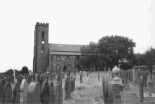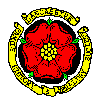
St James the Great
The name Haslingden probably derives from the dense growth of hazel trees which once flourished in the area - the dene of the hazels - Hazeldene, and appears in various records as Hesselingedon, Hasslingden, Hassclindene and eventually Haslingden.
The date of the first church at Haslingden is uncertain. The first record of a church at Haslingden is in 1296. It was in this year that the monks of Stanlow, Cheshire petitioned their patron the Earl of Lincoln to give them a better site than the one on the banks of the River Mersey, which was prone to flooding from the sea, and they were granted the vicarage and church of Whalley. The parish of Whalley at this time consisted of seven dependent chapels of which one was Haslingden.
The Chapelry of Haslingden was served by Chantry priests, of which there was two, until 1536 when an Act was passed by Henry VIII ordering that all Chantries should be dissolved and that their revenue should be devoted to the King's use. Chantry Commissioners were appointed to seize all valuables belonging to the Chantries and it was reported that there were two "lyttell belles belonging to the Chapell at Haslingden", weighing over 9cwt and valued at £6. 15s. 0d. The bells remained at the church at this time.
After the Reformation and the establishing of the Church of England the Chapelry was served by Curates until it became an independent parish in 1867.
In 1550 King Edward VI ordered the inhabitants of Rawtenstall, Newhallhey, Gambleside, Loveclough, Crawshawbooth, Constable Lee, Oakenheadwood & Dunnockshaw should attend divine service at Newchurch, but the people were so against this order that they petitioned Queen Elizabeth I, and at a Commission held in Manchester on 29th January 1585 they were permitted to return legally to their original place of worship at Haslingden and it's chapel of ease at Goodshaw.
The Chantry Commissioners of Queen Mary reported that in a sworn deposition by the Curate of Haslingden, one of the "lyttell belles" had been taken away by Francis Garside of Ewood Hall and John Nuttall of Newhallhey and the other one had remained at the chapel. Both of the bells were seize by the Commissioners.
The church of 1284 was rebuilt between 1550 and 1574 and the tower arch and font still remain in the church today.
The church was rebuilt again following its collapse shortly after Sunday morning service. The burial register as the following entry date 17th February 1772: "Mary, daughter of Robert Ashworth of Sabden, who had her grave made near the pillar which occasioned the church to fall before she was buried."
The church remained in ruins until the middle of 1773 when sufficient monies had been raise for building work to commence. During the time that the church was being re-built baptisms, marriages and burials were performed in the tower which had survived the collapse of the old church. The new church was completed in 1780 at a cost £1449 and had seating for 988 people. The new church was added to in 1827 when the Tudor Tower was pulled down and the present one was erected at a cost of £900. The church was also extended eastwards to provide an additional 540 seats and a re-arranging of the old seating to give a total of 1600 seats.
The Chapelry of Haslingden became a Vicarage on 21st Decembers 1867.
The graveyard has no gravestones of any great age, the oldest one being a small one with the initials and date ECP. 1629. In 1793 twenty-one perches were added to the graveyard. Further enlargements were in 1821 on the north side of the church. In 1846 on the south-west and in 1866 on the south side.
The registers date from 1598 in fragments until about 1603. These have now been transferred to the County Records Office in Preston for preservation and safe keeping.
After the "two lyttell bells" of the 16th century were seized they were eventually replaced by three new ones which remained in the tower until it was pulled down in 1827. The present peal of eight bells were cast in 1830 and placed in the new tower. In 1831 the clock in the tower was purchased by public subscription.
There was an organ in the church in 1792, A new one was -installed in 1832 and this was again replaced by a new one by Villis of London in 1878. This was enlarged and rebuilt in 1923. The organ was put at the east end of the north aisle and a new porch was built on the north side of the church.
There is an old iron bound chest in the present Lady Chapel believed to have been constructed no later "than Norman times". The Lady Chapel was dedicated on Sunday 10th September, 1961.
The stone reredos was presented to the church by Dr. Ralph Holden in 1856. It was carved by William Barnes from stone quarried at Hutchbank.
In the churchyard there is a large stone which is supposed to be the base of an old Saxon Cross similar to those at Whalley. This cross was mentioned in the Clitheroe court rolls in 1547 so it could have been destroyed during the Reformation or later during the Commonwealth. It has also been called a "plague stone" and it may have been used for that purpose when there was an outbreak of plague in the town.
The retaining wall of the graveyard collapsed in 1950, Some of the land and grave contents blocked the main road.
In 1951 the pinnacles were removed from the tower as they were unsafe.
In 1957 a new Vicarage was built on land to the east of the church at a cost of £9,100.
In 1970-71 the Parish Hall was built on land behind the vicarage. Most of the money for this was received in compensation for the Mission Building in Hindle Street. This having been demolished in the Councils re-development scheme.
The church was rewired in 1977 at a cost of £5000. The money being raised by public subscription. The church was re-roofed in 1979 at a cost of £5000 and in 1980 the inside of the church was re-decorated.
There was an arson attempt on the church in August 1998 and this brought forward a refurbishing scheme previously agreed by the Parochial Church Council. The refurbishing work was started in June 1999 and service were held in the Day School whilst this work was carried out . The church was re-open for worship on 25th February 2000.
Parish Registers
| Baptisms | 1598 - 1902 | Rawtenstall Library(LPRS Vol.139 & microfilm) | |
| 1603 - 1902 | Lancashire Record Office(original registers) | ||
| 1837 - to date | Haslingden Roots | ||
| Marriages | 1598 - 1698 | Rawtenstall Library(LPRS Vol.139 & microfilm) | |
| 1711 - 1959 | Rawtenstall Library(mfilm) | ||
| 1603 - 1698 | Lancashire Record Office(original registers) | ||
| 1711 - 1959 | Lancashire Record Office(original registers) | ||
| 1837 - to date | Haslingden Roots | ||
| Marriage index | 1813 - 1837 | Rawtenstall Library, Manchester Central Library(microfilm) | |
| Burials | 1589 - 1924 | Rawtenstall Library(LPRS Vol.139 & mfilm) | |
| 1603 - 1924 | Lancashire Record Office(original registers) | ||
| 1837 - to date | Haslingden Roots | ||
| Monument Inscription & index | 1715 - 1977 | Rawtenstall Library(microfiche & book) |

St James the Great, Haslingden - 26th December 2004

St James the Great - Nave and Sanctury




